Why Now Is the Time to Visit Northern Ireland — Plus Where to Eat, What Do, and Places to Stay
Nearly 25 years after the Troubles, Northern Ireland’s scars are finally beginning to heal. Here's a guide to the best of the country right now.
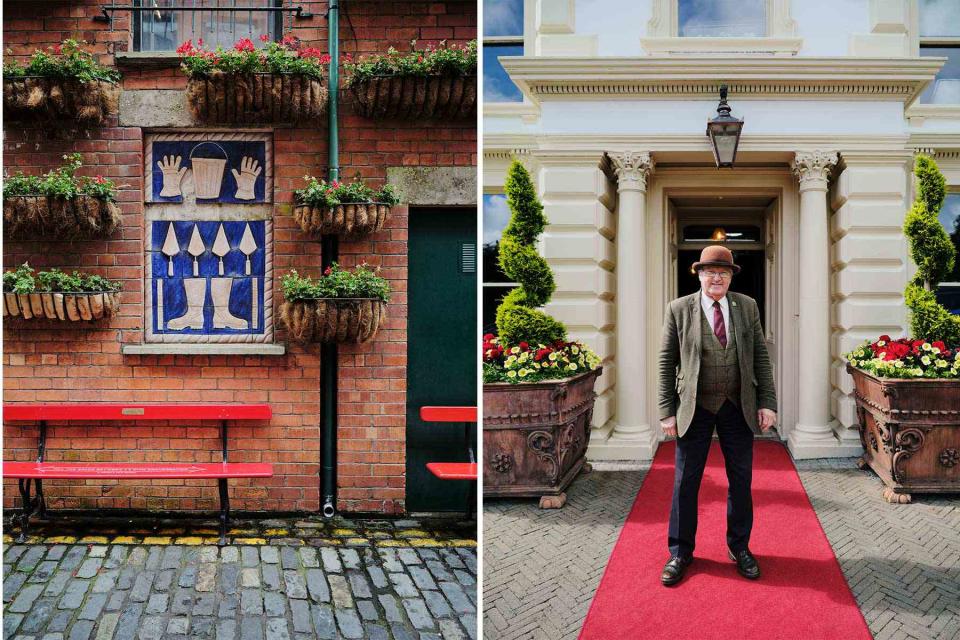
Simon Watson
From left: Decorative details in the Cathedral Quarter; doorman Maurice Johnston at Galgorm, a hotel and spa in Ballymena, Northern Ireland.Northern Ireland. What do those words bring to mind? Recently, I put the question to two American friends. “The Troubles,” said the first. “The Troubles,” said the other.
They were referring to the sectarian violence between largely pro-Britain, Protestant Unionists and largely pro-Ireland, Catholic Republicans that made Belfast a deadly place from the 1960s to the 90s. Riots, bombings, clashes between paramilitary forces, and attacks by the British army killed more than 3,500 before the 1998 Good Friday Agreement brought a tentative peace.
Having been born in the former Soviet Union, I’ve always been drawn to places known more for political headlines than for tourism. There, I’ve often discovered underappreciated destinations rather than security problems. Over the past few years, I had been hearing that things were changing in Ulster. I began to wonder if Northern Ireland was another of these secret marvels, waiting for the world to notice how outdated our assumptions about it had become. So I decided to plan a trip.
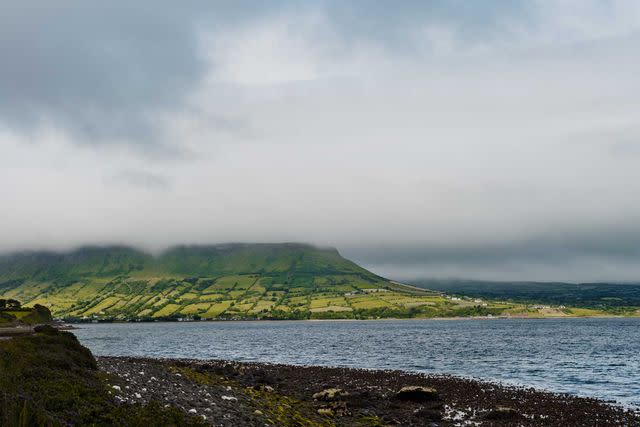
Simon Watson
The shoreline between Carnlough and Waterfoot, part of Portia Woods’s Toast the Coast tour.My first stop in Belfast was the resplendently Victorian Merchant Hotel, a former bank with a soaring lobby that now survives as the Great Room, the restaurant where my eggs and croissants vanished under the beatific gaze of golden-faced cherubs mounted on colonnades. The Merchant’s conversion, in 2006, into a world-class hotel epitomizes the transformation of Belfast’s Cathedral Quarter, the elegant, cobblestoned heart of downtown. During the Troubles — when the threat of bombing, particularly in densely populated areas, was constant — the Quarter was all but deserted, a testament to former glory. Today, it is an international destination for dining and design.
As I met artists, farmers, lords, chefs, and Troubles survivors, the Northern Irish character came to feel like a glorious paradox: the warmest and least sentimental people I’d ever met.
But this cosmopolitanism hasn’t rubbed the edge off what makes the Quarter so different. The poetry, surely, is part of it. Northern Ireland gave the world the poets Seamus Heaney, Paul Muldoon, and Louis MacNeice, and I navigated the Quarter’s uneven stones surrounded not by international retailers, as in so many other European capitals, but by doorways and railings adorned with poems stenciled onto metal panels. The unsanitized view of the Troubles presented in the ubiquitous political murals — interrogations, protest marches, the bloody aftermath of a bombing — amplifies the sense of having wandered into a tourist district from a very different kind of brochure.
As I walked around, I came to a wall emblazoned with a poem by the early-20th-century Northern Irish writer Raymond Calvert, about a gentleman driven to such insanity by his “curse” of a wife that he slashes her throat, but then, in remorse, hangs himself with a sheet. “But the strangest turn to the whole concern/Is only just beginning,” the last stanza declares. “He went to Hell but his wife got well/And she’s still alive and sinning./For the razor blade was German made/But the sheet was Belfast linen.”
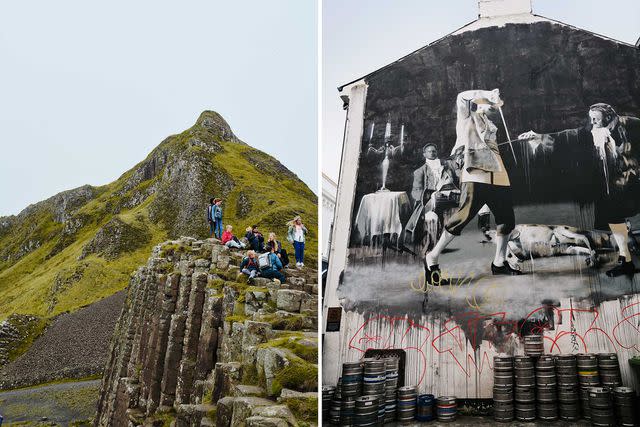
Simon Watson
From left: The Giant’s Causeway, a natural formation of basalt columns on the North Coast; The Duel of Belfast, Dance By Candlelight, a mural by Conor Harrington in the Cathedral Quarter.A Northern Irish accent, during the Troubles, “would make people edge away from you on the London Tube,” Kieran Gilmore, a cultural organizer, told me. That sense of inferiority has given way to the unapologetic pride, leavened by gallows humor, epitomized by Calvert’s comic poem. As I met artists, farmers, lords, chefs, and Troubles survivors, the Northern Irish character came to feel like a glorious paradox: the warmest and least sentimental people I’d ever met.
Belfast is small, and visitors don’t have to walk far for the Quarter and its polish to give way to areas with less evolved views on the Troubles. I took that walk with a guide named Colm McBrierty. As a musician during the Troubles, McBrierty, who has a recognizably Catholic surname, listed himself as Colin Smith so he could play in bars in Protestant areas. In 1972, his mother missed a weekly lunch date at the Abercorn Restaurant in the city center and, by doing so, avoided a bomb that killed two and injured 130.
More Trip Ideas: 8 Most Scenic Train Rides In the U.K.
A walk through West Belfast, where you need the eyes of a native to understand that you’ve crossed from a Unionist street to a Republican one, is a bracing reminder of how intimate the sense of violence must have been. McBrierty and I stopped by a “peace wall” set up by the British government — a euphemism for a barrier between the communities. The Unionist side features quotes by the Dalai Lama and work by local artists. The Republican side has nothing but barracks-green paint. In both Unionist and Republican areas, we saw murals commemorating victims, but also murderers. (In one, thanks to a chilling visual effect, the muzzles of rifles held by two painted men in balaclavas seemed to follow us as we drove past.) But we saw just as many murals by community groups urging reconciliation.
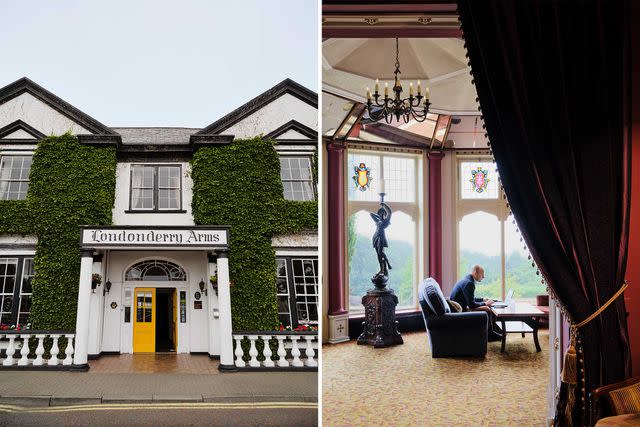
Simon Watson
From left: The Londonderry Arms hotel, in Carnlough; the conservatory at Culloden Estate & Spa, in Holywood.McBrierty suggested that neither side had sole claim to the truth. “There are two cultures on this island, and both have to be respected — that’s the short of it,” he said. He was both clear-eyed and optimistic. “These disagreements won’t end for a couple of generations,” he said. “People died too recently. But we’ve come a very long way.” McBrierty and his wife, a Protestant, sent their children to an “integrated” school. “People say, ‘Are you Catholic or Protestant?’ ” McBrierty said. “I say I’m an Ulster man.”
I thought of McBrierty’s unvarnished eloquence when I had dinner at Wine & Brine, in the village of Moira, in County Armagh, a 20-minute drive southwest of Belfast. Chris McGowan, the chef, cooked in London for 20 years before deciding to return to Northern Ireland with his family in 2014. “We came back for the people,” McGowan said. “People here are so genuine. They’ve gone through so much. And it’s such an exciting food scene at the moment.”
Wine & Brine is a family affair in multiple ways: McGowan’s wife, Davina, manages the front of the house, and the restaurant draws as many couples on dates as multigenerational family outings and retirees on weekly lunch engagements, giving the place an easygoing quality that belies the ambition of the cooking. (That day, the chef was serving pig’s-head doughnuts with malt vinegar and smoked eel from Lough Neagh, just west of Moira.)
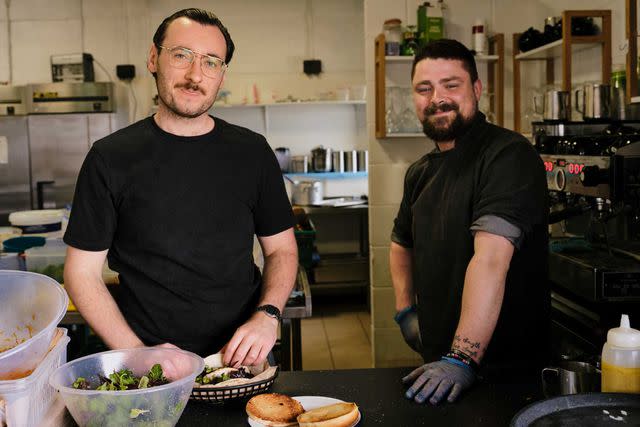
Simon Watson
Staffers at Native Seafood & Scran, a sustainable fish store and café in Portstewart.The feeling is similar at Noble, a dark-walled 26-seat restaurant with a kitchen the size of a phone booth, in Holywood, just outside Belfast. Chef Pearson Morris raids the fields and waters that make the Northern Irish larder so bountiful: I had a tartare of local beef with gribiche sauce; lamb shoulder with curry oil and mint raita; and a weightless halibut with chanterelles in a roasted-bone sauce. But it was co-owner Saul McConnell’s service — warm and unobtrusive, but with a sense of occasion — that made the evening. Noble was the recipient of the Michelin Guide’s 2021 Welcome & Service Award. Belfast has three Michelin-starred restaurants, but the best meals I had were at restaurants like Wine & Brine and Noble, which cook for the neighborhood as if it were a global stage.
McGowan and McConnell are part of a growing number of entrepreneurs creating things the country hasn’t seen before. For instance, the creative director Ryan Crown had a thriving career in Brooklyn when he came home for a visit at the start of the pandemic. He encountered a Belfast transformed, with so much demand in his field that he stayed. One of his earliest endeavors was Hill Street Hatch, a Cathedral Quarter incubator that was set up to help local entrepreneurs with marketing and branding. Its first project was the Toast Office, a grilled-cheese shop whimsically designed to resemble an old British post office. It became an Instagram sensation.
A deep feeling for the land is, perhaps, one of the few things that unites virtually every soul in the country. No trip to the countryside would be complete without a glimpse of the legendarily beautiful North Coast.
Around the corner on Donegall Street, Richie Stokes and Gareth Young run Never Never, a shop for skater fashions created on the counterintuitive premise that the city’s young people prefer to buy their hoodies from human beings instead of algorithms. On Little Donegall Street, Mike Thomson slings farmstead cheese from small Irish and Northern Irish producers at a shop whose name, Mike’s Fancy Cheese, sends up in classic Irish fashion the solemnity with which certain shops sell artisanal goods.
To experience the unassuming creativity of Belfast’s young entrepreneurs is to rediscover some of the wonder we’ve lost in places where creativity has become commodified. That they live in a city that remains affordable enough for them to lease commercial spaces downtown is essential to that ferment. So is the fact that they borrow equally from British and Irish influence. As Colm McBrierty suggested, perhaps the right answer to the question “Britain or Ireland?” is: “Both.”
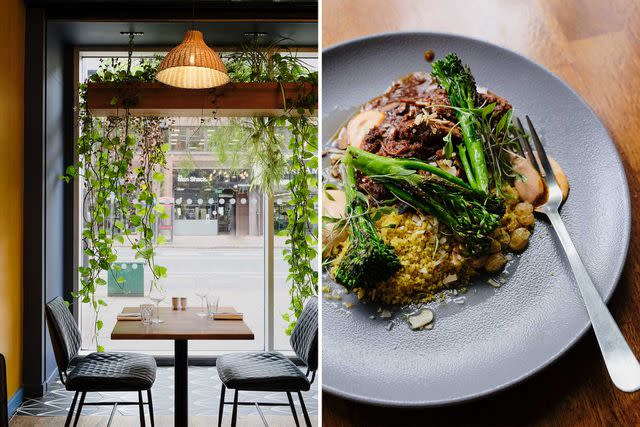
Simon Watson
From left: Home, a contemporary Irish restaurant in central Belfast; a Persian lamb entrée at Home.Midway through my stay in town, I relocated to the Titanic Hotel Belfast, a 25-minute walk east of downtown. Against all odds, this theme hotel is a thoughtful, stylish place of pewter accents and floor-to-ceiling windows that give out onto the shipyard where the Titanic was built. The hotel is next to the Titanic Belfast museum, opened in 2012, whose striking exterior of massive shimmering panels is home to impressively curated, immersive exhibits that manage to reclaim the story from Hollywood. But perhaps my favorite thing about the Titanic Quarter was the walk it required from the action downtown, across the river Lagan, which bisects the city before emptying into the Belfast Lough and the Irish Sea. Belfast’s intimate size and mash-up of Victorian and postindustrial spaces make it a flaneur’s delight. The British side of its charm includes Black English taxis. I never took one.
Related: The Best Time to Visit Ireland
Unlike those places where the capital city siphons off the best of the provinces, Northern Ireland’s transformation has also reached deep into the countryside. In the seaside town of Bangor, a half-hour’s drive east of the city, I met the cultural organizers Alison Gordon and Kieran Gilmore. The couple returned home from London after the Good Friday Agreement because they wanted to use the arts to help create a “new, shared Northern Ireland,” Gilmore told me. As they walked me around, sea brine in our lungs, they showed me what two decades of peace had allowed them to achieve.
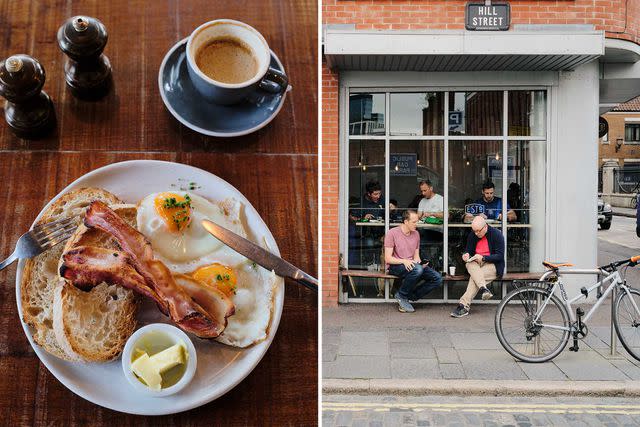
Simon Watson
From left: A well-rounded breakfast at Established Coffee, in Belfast’s Cathedral Quarter; catching up outside Established Coffee.Gordon and Gilmore pointed out murals by artists they’ve hosted (in one, the London artist Irony had given a crab the chef’s knife), performance spaces for a music festival they organize every year, and an abandoned courthouse that they are transforming into an arts center. “Dereliction is an opportunity,” Gordon said. “It’s not the end — it’s the beginning.”
If towns like Bangor have looked to the arts, the Northern Irish countryside owes its revival to the same elements that have sustained it since the beginning of time: rain and soil. In County Armagh, southwest of Belfast, entrepreneur Susie Hamilton Stubber of Burren Balsamics welcomed me into the country kitchen of my dreams, where the air was thick with the smell of the wheaten bread, a type of soda bread, that she had baked for our lunch. Here, Stubber and her business partner, the chef Bob McDonald, infuse vinegars, chutneys, marmalades, and piccalillis with local bounty as well as imports from Britain’s erstwhile empire: beets and cocoa nibs, Irish cherry, blood orange and cardamom.
The encounter of the Irish Sea and the North Atlantic nearby, Woods said, made for some of the best waves in Europe, still a relative secret among the Continent’s surfers.
McDonald spent 45 years cooking for the officers’ mess in the British army. (British officers eat well, he said — the cuisine was fit for a Michelin-starred restaurant.) For lunch, he finished a saddle of local venison, cooked sous-vide, by searing it in butter and some of Stubber’s garden thyme, as well as a stock of Pinot Noir reduced with a vinegar infused with blackberry and thyme. This arrived alongside a miniature lamb pie, foraged blackberries, white-currant jelly, and root vegetables. “It took some time,” McDonald said. “But people are beginning to realize that what we have is as good as anywhere.”
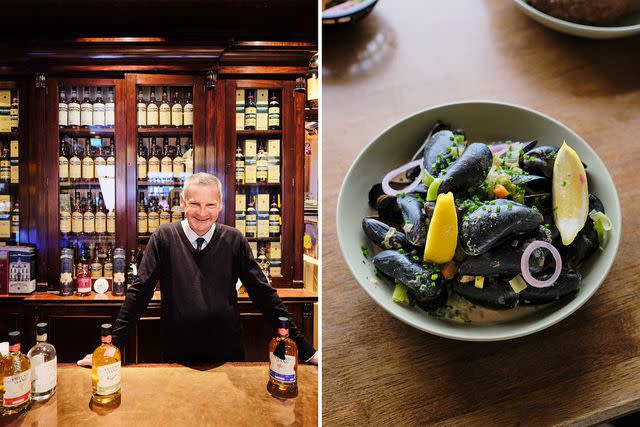
Simon Watson
From left: Ray Gallen at his Belfast whiskey shop, the Friend at Hand; mussels from the Native Seafood & Scran café.Even peers of the realm get in on the act, as I learned when I visited Ballywalter Park, a 270-acre estate where the unpretentious Lord and Lady Dunleath welcome visitors for tours. A lunch of local cheeses and Lord Dunleath’s own beet chutney culminated in a walk through the massive walled garden, which supplies some of Belfast’s best restaurants. “These are the pearly gates,” Lady Dunleath said as we approached the entrance, pheasants clearing out of our path, adding that paradise is Pashtun for walled garden. The couple grow edible calendula, black sunflowers, pinto peaches, gooseberries, Jerusalem artichokes, and more. “This was the 18th century’s supermarket,” she said. “When the newspapers are saying what they’re saying about climate change, you must look to your doorstep. The Irish Sea is 500 meters from here. I can have lobster from June to New Year’s Eve.” Ballywalter is in the process of going entirely off the grid, she told me.
A deep feeling for the land is, perhaps, one of the few things that unites virtually every soul in the country. No trip to the countryside would be complete without a glimpse of the legendarily beautiful North Coast. I explored it with the entrepreneur Portia Woods, who has turned her love of the region into a tour called Toast the Coast. As we drove along the craggy shoreline, the roar of the surf seemed to intensify instead of becoming familiar. On the sweep of Benone Strand Beach, Woods set up a picnic of soda-bread crostini, apple butter, and kelp pesto. Under a cold sun, we listened to the thundering waves on repeat: crash, hiss, repeat. The encounter of the Irish Sea and the North Atlantic nearby, Woods said, made for some of the best waves in Europe, still a relative secret among the Continent’s surfers.
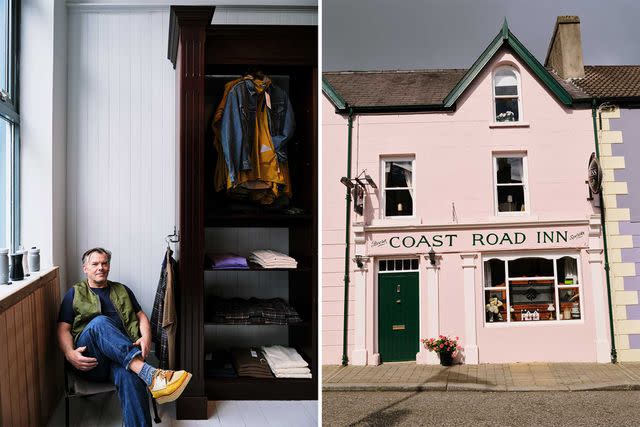
Simon Watson
From left: Paul Craig at his Belfast menswear shop, the Bureau; the Coast Road Inn, outside Carnlough.Our most moving stop was the speck-sized town of Portstewart, where Woods introduced me to Stevie McCarry, who runs Native Seafood & Scran with his wife, Rebekah. Like so many in Northern Ireland, McCarry grew up without pride in the natural riches around him. “Back in the day, if you came to school with lobster in your lunch, another kid would give you their milk because they felt bad for you,” he said. As a young man, he moved to Thailand. “We all went to the far side.”
But at some point, McCarry started to understand what he’d left behind. He and Rebekah opened Native out of a frustration that Northern Ireland’s best catch was going to France rather than staying at home. Their offerings are so fresh that the shop has no microwave or freezer. As an experiment, I ordered the plainest-seeming thing on the menu: a roasted-salmon salad. Decorated by nothing save lightly dressed greens, the salmon was elementally, profoundly flavorful.
“We’re all starting to understand what we have,” McCarry said.
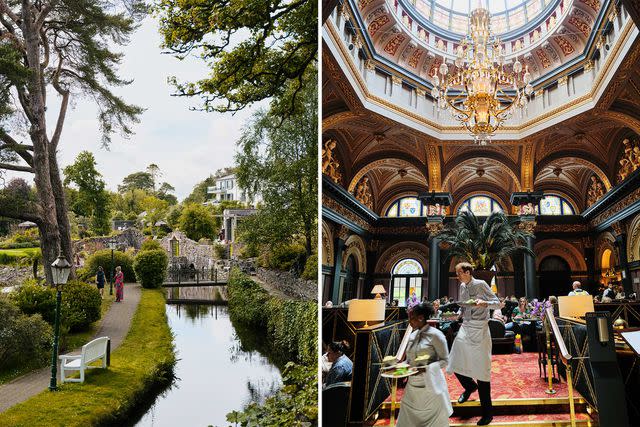
Simon Watson
From left: The gardens of the Galgorm resort and spa; the Victorian-era dining room at Belfast’s Merchant Hotel.A Northern Irish Journey
Where to Stay
Culloden Estate & Spa: Located just outside the capital, this former bishop’s palace has views of Belfast Lough and an unmissable afternoon tea.
Galgorm: This resort, in the town of Ballymena, is home to a spa “village” with so many steam rooms, waterfalls, plunge pools, and hot tubs that it’s almost impossible not to get blissfully lost.
The Merchant Hotel: A prime example of Belfast’s Victorian splendor enlivened by a bit of contemporary style. Don’t skip its cocktail bar.
Titanic Hotel Belfast: Located by the Titanic museum and the shipyard where the ocean liner was built, this elegant hotel evokes the high style of the Gilded Age.
Where to Eat and Drink
The Duke of York: The flagship of the pubs owned by entrepreneur Willie Jack; he’ll give you a proper pint and a monologue for the ages. Stop by his whiskey shop, the Friend at Hand, around the corner.
Home: Situated on an ordinary Belfast block, Home is one of those unicorn restaurants of wild imagination and flawless technique that still manages to feel like your neighborhood bistro.
Noble: Electric cooking from a tiny kitchen and unfussy, festive service are the highlights of this low-lit restaurant in Holywood, just outside Belfast.
Wine & Brine: Chris McGowan cooked in London for 20 years before returning home to Belfast to take advantage of the glory of his native fields and waters, which can include smoked eel or turbot caught that morning.
What to Do
Ballywalter Park: When they’re not lending their 270-acre estate out to film crews, Lord and Lady Dunleath host tours of their property, with its endless fields, 18th-century walled garden, and epic solarium.
Spectrum Cars: This chauffeur company offers a tour of Belfast’s Troubles that’s anything but canned, especially if Colm McBrierty is your guide.
Titanic Belfast: This immersive, informative museum in a gorgeous Modernist building provides
a clear-eyed look at the famous ship’s tragic history.
Toast the Coast: The entrepreneur Portia Woods has turned her love of the North Coast into an exhilarating tour of spectacular landscapes and innovative projects by local proprietors.
Where to Shop
Armagh Cider: The only blossom-to-bottle cider operation in Northern Ireland. A three-course lunch is served to those who book a tasting of ciders, vinegars, and tonics.
Bound: A home-décor store in Belfast that showcases boundary-breaking Northern Irish and European designers.
The Bureau Belfast: Cool menswear from such indie brands as Engineered Garments and Arpenteur.
Burren Balsamics: In County Armagh, the entrepreneur Susie Hamilton Stubber and former military chef Bob McDonald infuse high-end Italian vinegars with Bramley apples, cocoa nibs, and other surprises. See if you can score a peek inside Stubber’s country kitchen.
Never Never: Undeterred by a recent fire, this skater-style shop is selling its wares online while it prepares to reopen.
How to Book
Siobhan Byrne Learat, a member of T+L’s A-List of top travel advisors, can orchestrate a journey across Northern Ireland that encompasses five-star hotels, walking tours of Belfast, and visits to the artisanal producers who are transforming the country’s culinary scene. Email: siobhan@adamsandbutler.com.
A version of this story first appeared in the December 2022/January 2023 issue of Travel + Leisure under the headline "Come One, Come All."
For more Travel & Leisure news, make sure to sign up for our newsletter!
Read the original article on Travel & Leisure.

